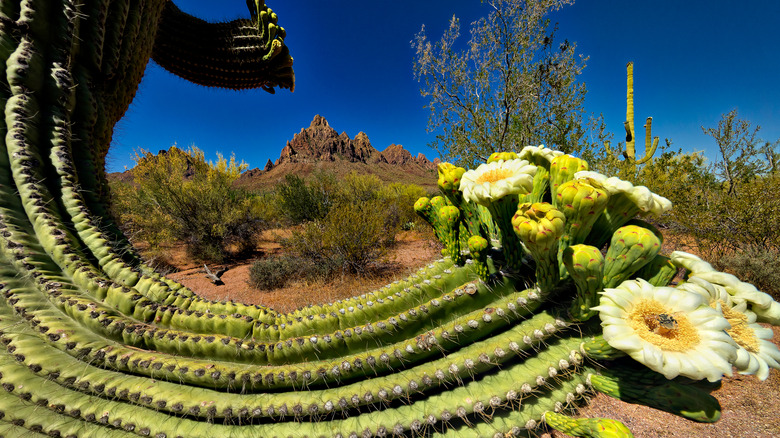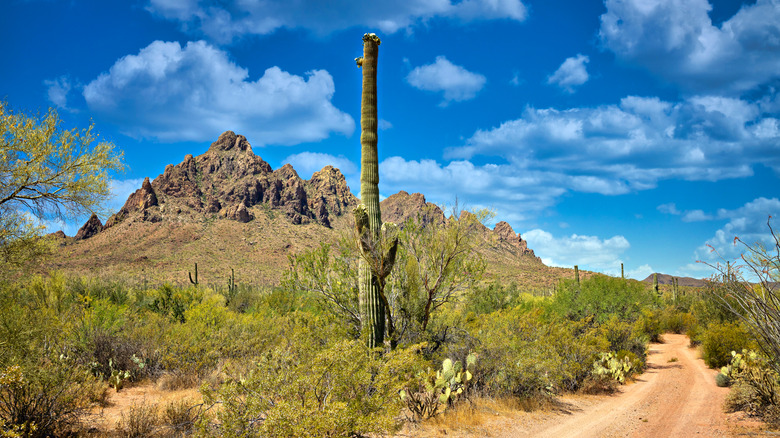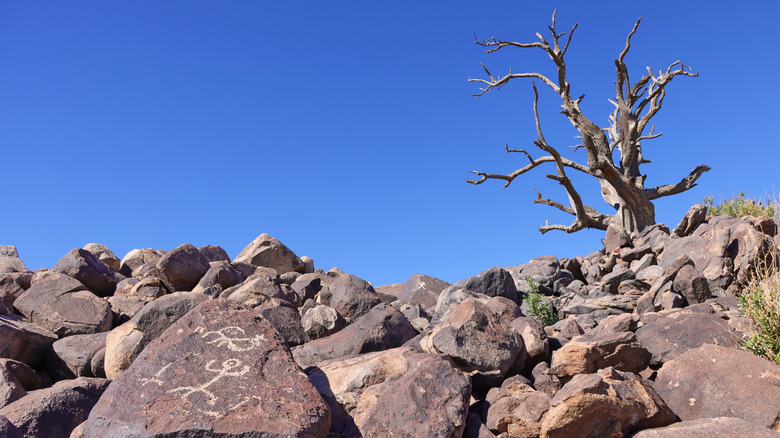Arizona's Secret Cactus Forest Is A Barely Visited Top Destination For Rare Plants And Wildlife
Free camping, no entrance fees, rare plants, unique desert animals, and very few visitors. If this sounds like the kind of adventure you're looking for, add Ironwood Forest National Monument to your travel plans in 2025. The monument, which covers 129,000 acres, was only created by President Bill Clinton in 2000. And though there are older, larger cactus forests in the Southwestern U.S. — Organ Pipe Cactus National Monument and Saguaro National Park come to mind — Ironwood Forest is well worth a visit for some zen strolls along the cacti.
This rugged, remote area has no amenities, but you're trading those luxuries for solitude among stately saguaro cacti. With a few tips, the right vehicle, and plenty of water, this hidden gem will take your breath away, leave you with a full gallery of pictures, and give you a glimpse of what Arizona looked like thousands of years ago. If after reading our tips, you decide this trip is a bit too adventurous, Saguaro National Park is just a few miles away. It's equally stunning and offers plenty of amenities.
What to expect in Ironwood Forest
Ironwood Forest offers vast desert solitude that's unmatched by its more famous neighbor, Saguaro National Park West. Saguaro (which is divided into two parks) welcomes more than 1 million visitors annually to its well-maintained trails, water stations, and visitor center. Ironwood Forest by comparison is massively underrated and uncrowded: Just 125,000 people visited the Ironwood in 2023, making it the perfect place for those who want to enjoy quiet, rugged desert landscapes.
However, the monument's remoteness comes with challenges. There are no amenities such as water, bathrooms, or developed trails. To safely enjoy your visit, it is recommended that you drive a high-clearance vehicle and bring plenty of water, printed or downloaded maps, and a travel companion. Share your plans with someone who isn't going on the trip, and follow other safety tips for solo travelers. Remember that the area is occasionally used as a crossing for illegal migrant activity, so situational awareness is essential. In the summer, this area sees powerful monsoon storms that can lead to flooding, so be sure to watch the weather forecast too.
In addition to thousands of saguaro cacti, Ironwood Forest National Monument is home to ironwood trees, the longest-living trees in the Sonoran Desert and an important part of the desert ecology. The wood of the tree is so dense, it actually sinks in water. In the spring, the tree blooms with purple flowers. The saguaro cactus generally blooms in the summer. The diverse landscape also features mesquite, palo verde, creosote (which gives desert rain its unique smell in the summer), and the endangered Nichol's Turk's-head Cactus. Wildlife enthusiasts may spot desert tortoises, Gila monsters, roadrunners, jackrabbits, and mule deer. This wilderness is also home to the last indigenous desert bighorn sheep in the region.
What to do in Ironwood Forest
Whether you take a scenic drive, go hiking, or try mountain biking in Ironwood Forest, the monument offers plenty of ways to experience its natural beauty. Stargazing and astrophotography are also popular activities, since you'll be so far away from any city lights. The Tucson area takes the beauty of its dark skies seriously, with ordinances to limit light pollution that have been in effect for decades.
Don't forget to look up at the mountains, either. One peak, aptly named "Ragged Top," is a volcanic plug with a rugged summit that's perfect for a daytime hike. As you hike, you can take in the ancient beauty of Ironwood Forest, whose rich history spans more than 8,000 years. With more than 200 prehistoric Hohokam sites, the monument also boasts three locations listed on the National Register of Historic Places. Most of the historic sites are remote and unmarked to protect them. While enjoying this area, it's essential that you leave no trace.
A few areas are developed, including the Waterman Restoration Site, where an old airstrip has been painstakingly restored to its natural state through years of effort and thousands of volunteer hours. You can also explore remnants of Cold War history at a former Titan Missile Silo site, marveling at the thought of people once stationed here. Nearby, the Silver Bell Cemetery serves as the last reminder of the once-thriving mining town of Silver Bell. To gain a deeper understanding of the area, visit the Arizona-Sonora Desert Museum, the world-famous botanical garden, zoo, and aquarium that tells the story of this special desert that stretches from Mexico into the Grand Canyon state.


